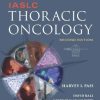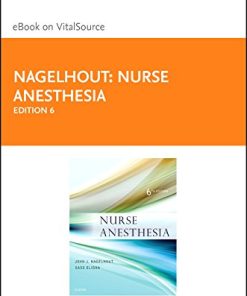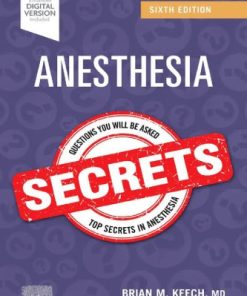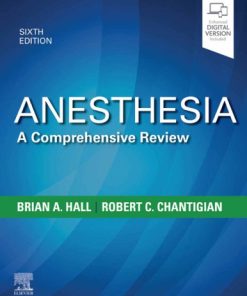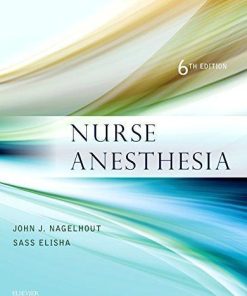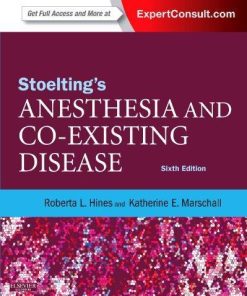Nurse Anesthesia 6th Edition by John Nagelhout, Karen Plaus 0323444378 9780323444378
$50.00 Original price was: $50.00.$25.00Current price is: $25.00.
Nurse Anesthesia 6th Edition by John J. Nagelhout, Karen Plaus – Ebook PDF Instant Download/DeliveryISBN: 0323444378, 9780323444378
Full download Nurse Anesthesia 6th Edition after payment.
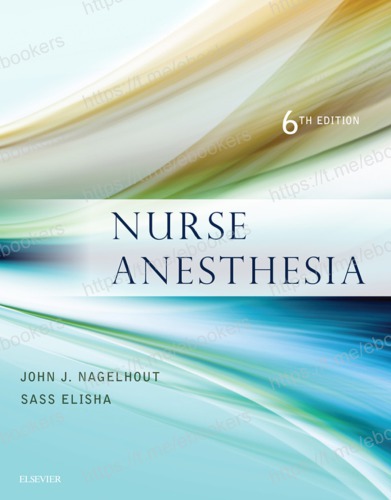
Product details:
ISBN-10 : 0323444378
ISBN-13 : 9780323444378
Author : John J. Nagelhout, Karen Plaus
Gain a thorough understanding of nursing anesthesia with the most comprehensive text on the market. Written by leading expert, John Nagelhout, CRNA, PhD, FAAN, and new contributing author Sass Elisha, EdD, CRNA, Nurse Anesthesia, 6th Edition features both scientific principles and evidence-based material. Inside you’ll find a solid introduction to the history, education, and legal issues of nurse anesthetist, its scientific foundations, equipment and monitoring, and preoperative evaluation and preparation of the patient. This new edition includes chapters on patient centered care and cultural competence, additional drugs of interest, blood and blood component therapy, anesthesia management for patients with cardiac devices, anesthesia for robotic surgery, anesthesia for transplant surgery and organ procurement, and physiology and management of acute and chronic pain. Not only a key reference for practicing nurse anesthetists, this bestseller prepares you for certification and today’s clinical anesthesia practice.
Nurse Anesthesia 6th Table of contents:
1 Nurse Anesthesia
The Problem of the Occasional Anesthetists
Historical Antecedents of the Nurse as Anesthetist
Anesthesia: Medicine, Nursing, Dentistry, or What?
Organization: “We Who Are Most Interested”
World War II and Nurse Anesthetists
A Short-Lived Peace for Nurse Anesthetists and the Nation
The New Age of Nurse Anesthesia: the 1960s
The 1970s: A Turbulent Decade
Federal Legislative Initiatives in the 1980s
CRNA Achievements of the 1980s
The Call for Health Care Reform in the 1990s
Doctoral Preparation of Nurse Anesthetists Achieved
CRNA Practice Today
International Federation of Nurse Anesthetists
Progress in Anesthesia
Summary
References
2 Nurse Anesthesia Specialty Practice and Education in the United States
Nurse Anesthesia Educational Requirements
Certified Registered Nurse Anesthetist Practice
AANA Organizational Structure and Function
Summary
References
3 Patient Centered Care, Cultural Competence, and Nurse Anesthesia Practice
Patient-Centered Care: What It Is and Why Is It Important
Measurement of Health Care Quality in Anesthesia
Summary
References
Unit II Scientific Foundations
4 Nurse Anesthesia Research
Methods of Knowing
The Nature of Research
The Eight Critical Stages in the Research Process
Evidence-Based Practice: Empowering Decision Making Through Research
Evidence-Based Practice in Nurse Anesthesia
Summary
References
5 General Principles, Pharmacodynamics, and Drug Receptor Concepts
Receptor Structure
Drug Response Equation
Pharmacogenetics
Population Variability
Drug Dose Response
Drug Receptor Interactions
Drug Antagonism
Summary
References
6 Pharmacokinetics
Properties That Influence Pharmacokinetic Activity
Other Factors That Influence Pharmacokinetics
Pharmacogenetics and Pharmacogenomics
Summary
References
7 Pharmacokinetics of Inhalation Anesthetics
Primary Factors Controlling Uptake, Distribution, and Elimination of Anesthetics
Pediatrics
Other Factors
Summary
References
8 Inhalation Anesthetics
Relationship Between Chemical Structure and Agent Characteristics
Pharmacodynamics
Minimum Alveolar Concentration
Influence of Inhalation Agents on Organs and Systems
Inhalation Anesthetics and Pregnancy
Summary
References
9 Intravenous Induction Agents
Nonbarbiturate Intravenous Anesthetics
Benzodiazepines
Anesthetic Neurotoxicity
Summary
References
10 Local Anesthetics
Anatomy of the Peripheral Nerve
Neuron Electrophysiology and the Action Mechanism of Local Anesthetics
Chemical Structure of Local Anesthetics
Pharmacodynamics and Pharmacokinetic Concepts
Local Anesthetic Systemic Toxicity
Clinical Use of Local Anesthetics
Summary
References
11 Opioid and Non-opioid Analgesics
Opioids
Individual Opioids
Summary
References
12 Neuromuscular Blocking Agents, Reversal Agents, and Their Monitoring
History
Monitoring of Neuromuscular Blockade
Depolarizing Agents
Nondepolarizing Agents
Reversal of Neuromuscular Blockade
Cholinesterase Inhibitors
Anticholinergics
Summary
References
13 Autonomic and Cardiac Pharmacology
Autonomic Drugs—Sympathomimetic Amines
Direct-Acting α-Agonists
Mixed Function Agonists
Selective β2-Agonists
α-Receptor Antagonists
β-Adrenergic Blocking Agents
Statins
Antiplatelet Drugs
Cholinergics
Anticholinergics
Direct Vasodilators
Calcium Channel Blockers
Angiotensin-Converting Enzyme Inhibitors
Angiotensin II Receptor Antagonists
Anesthesia Management of Patients Taking Angiotensin Axis Blockers
Catecholamine-Depleting Agents
Tyrosine Hydroxylase Inhibitors
Catechol-O-Methyltransferase Inhibitors
Cardiac Glycosides
Management of Specific Diseases
Preoperative Administration of Cardiac Drugs
Summary
References
14 Additional Drugs of Interest
Perioperative Antibiotics
Antiemetics and Perioperative Nausea and Vomiting
Psychiatric Drugs and Anesthesia
Summary
References
15 Chemistry and Physics of Anesthesia
General Chemistry: Matter and Energy
Newtonian Physics
Thermodynamics
Quantum Physics
References
Unit III Technology Related to Anesthesia Practice
16 Anesthesia Equipment
Organization of the Anesthesia Gas Machine
Supply
Processing
Delivery
Disposal
Risk Management
Summary
References
17 Clinical Monitoring I
Electrocardiogram Monitoring
Central Venous and Arterial Hemodynamic Measurements
Arterial Pressure Monitoring
Transesophageal Echocardiography Monitoring
Summary
References
18 Clinical Monitoring II
Monitoring Standards
Alarm Fatigue
Systematic Approach to Monitoring
Airway Monitoring
Additional Monitoring Issues
Anesthesia Education and Patient Monitoring
Summary
References
19 Clinical Monitoring III
Electroencephalogram
Processed EEG Waveforms
Monitors for Assessing Central Nervous System Blood Flow and Oxygenation
Evoked Potentials
Bispectral Index
Summary
References
Unit IV Preoperative Preparation
20 Preoperative Evaluation and Preparation of the Patient
Preanesthesia Assessment Clinic
Chart Review
Patient Interview
Patient Evaluation: Overview of Systems
Diagnostic Testing
Fasting Considerations
American Society of Anesthesiologists Physical Status Classification System
Preventing Operative Errors
Summary
References
Unit V Intraoperative Management
21 Fluid Administration, Perioperative Goal-Directed Fluid Therapy, and Electrolyte Disorders
Fluid Volume, Types of Fluids, and Overview of Fluid Management
Normal Physiologic Distribution and Regulation of Fluids
Composition and Relative Advantages of Various Intravenous Fluids
Impact of Surgery and Anesthesia on Vascular Flow and Organ Perfusion
Historical Approach to Fluid Management
Perioperative Goal-Directed Fluid Therapy
Electrolyte Balance
Summary
References
22 Blood and Blood Component Therapy
Estimation of Blood Volume and Loss
Transfusion Thresholds and Indications
Patient Blood Management
Conservation Strategies
Transfusion Compatibility
Emergency Transfusion
Massive Transfusion Protocols
Fractionation
Best Practice Transfusion Guidelines
Blood Storage
Complications of Blood Transfusion
Summary
References
23 Positioning for Anesthesia and Surgery
Physiologic Effects of Surgical Positions
Pathophysiology of Nerve Injury
Factors Contributing to Nerve Injuries
Patient-Related Factors Contributing to Nerve Injuries
Perioperative Neuropathies
Brachial Plexus Injuries
Spinal Cord Injury
Postoperative Visual Loss
Other Position-Related Injuries
Surgical Positioning
Closed-Claims Studies
Summary
References
24 Airway Management
Anatomy and Physiology of the Airway
Airway Evaluation
Tracheal Intubation
Management of the Difficult and Failed Airway
Airway Blocks
Cricoid Pressure
Adjunct Airway Equipment and Techniques
Tracheal Extubation
Complications of Airway Management
Summary
References
25 Cardiovascular Anatomy, Physiology, Pathophysiology, and Anesthesia Management
Cardiovascular System
Vascular System
Hypertension
Mitral Stenosis
Mitral Regurgitation and Insufficiency
Aortic Stenosis
Aortic Insufficiency
Mitral Valve Prolapse
Cardiomyopathy
Summary
References
26 Anesthesia for Cardiac Surgery
Anesthetic Management of General Cardiac Surgery
Anesthetic Considerations for Specific Cardiac Diseases and Surgical Procedures
Summary
References
27 Perioperative Management of Cardiac Implantable Electronic Devices
Review of Pacemakers
Review of Implantable Cardioverter Defibrillators
Perioperative Period
Summary
References
28 Anesthesia for Vascular Surgery
Peripheral Vascular Disease
Abdominal Aortic Aneurysms
Abdominal Aortic Reconstruction
Thoracic Aortic Aneurysms
Aortic Dissection
Descending Thoracic and Thoracoabdominal Aneurysms
Endovascular Aortic Aneurysm Repair
Cerebrovascular Insufficiency and Carotid Endarterectomy
Carotid Artery Angioplasty Stenting
Summary
References
29 Respiratory Anatomy, Physiology, Pathophysiology, and Anesthetic Management
Anatomy and Physiology of the Respiratory System
Respiratory System Pathology
References
30 Anesthesia for Thoracic Surgery
Preoperative Preparation
Lateral Decubitus Position
One-Lung Ventilation
Anesthetic Management During One-Lung Ventilation
Thoracic Surgical Concerns
Complications After Thoracotomy
Summary
References
31 Neuroanatomy, Neurophysiology, and Neuroanesthesia
Organization of the Central Nervous System
Anatomy of the Central Nervous System
Peripheral Nervous System
Vasculature of the Central Nervous System
Electrophysiology
Neurotransmitters
Sensory Pathways
Motor Pathways
Neuroanesthesia
Intracranial Pressure
Neurophysiologic Monitoring
Anesthetic Considerations for Specific Procedures
Summary
References
32 Renal Anatomy, Physiology, Pathophysiology, and Anesthesia Management
Structure of the Kidney
Renal Physiology
Effects of Anesthesia on Normal Renal Function
Acute Kidney Injury
Chronic Kidney Disease
Preoperative Renal Assessment
Anesthetic Management of Patients With Advanced Renal Disease
Intravenous Fluid Management
Cystoscopy
Extracorporeal Shock-Wave and Laser Lithotripsy
Percutaneous Nephrolithotomy
Transurethral Resection of the Prostate
Laparoscopic Urologic Surgery
Robotic Urologic Surgery
Renal Transplantation
Open Nephrectomy
Summary
References
33 Hepatobiliary and Gastrointestinal Disturbances and Anesthesia
Liver Disease
Diseases of the Biliary Tract
Diseases of the Esophagus
Diseases of the Stomach
Pancreatic Disease
Diseases of the Intestinal Tract
Splenic Disease
Carcinoid Tumors and Carcinoid Syndrome
Summary
References
34 Anesthesia for Laparoscopic Surgery
Creation of the Pneumoperitoneum
Physiologic Effects of the Pneumperitoneum
Complications of Laparoscopic Surgery
Anesthetic Management
Postoperative Concerns
The Future of Laparoscopic Surgery
Summary
References
35 Anesthesia for Robotic Surgery
History of Robotic Surgery
Robotic Systems
General Anesthetic Considerations
Considerations for Surgical Subspecialties
Summary
References
36 Musculoskeletal System Anatomy, Physiology, Pathophysiology, and Anesthesia Management
Overview of Neuromuscular Transmission
Muscle Physiology
Musculoskeletal Pathophysiology and Anesthesia
Summary
References
37 The Endocrine System and Anesthesia
General Principles of Endocrine Physiology
Pituitary Gland
Parathyroid Gland
Pancreas
Diabetes Mellitus
Adrenal Glands
Thyroid Gland
Summary
References
38 Hematology and Anesthesia
The Normal Vessel Wall
Vessel Injury
Cell-Based Theory of Coagulation
Fibrinolytic System
Anesthetic Implications
Specific Disorders
Other Considerations
Summary
References
39 Thermal Injury and Anesthesia
Classification of Burn Injury
Etiologies of Burn Injuries
Treatment of the Burn Patient
Summary
References
40 Trauma Anesthesia
Etiology of Traumatic Injury
Coordinated Management of Care
Early Evaluation of the Trauma Patient and Common Injury Patterns
Blunt Versus Penetrating Trauma
The ABCDs of Trauma Anesthesia
Special Topics in Trauma Anesthesia
Summary
References
41 Anesthesia for Organ Transplantation
History of Organ Transplantation
Renal Transplantation
Pancreas Transplantation
Liver Transplantation
Lung Transplantation
Intestinal Transplantation
Anesthetic Considerations for the Organ Donor
Summary
References
42 Outpatient Anesthesia
Features of Outpatient Surgery
Patient Selection
Patient Evaluation and Preparation
Premedication
Anesthetic Considerations
Postoperative Considerations
Summary
References
43 Anesthesia for Ear, Nose, Throat, and Maxillofacial Surgery
Functional Anatomy of the Head and Neck
Preparation and Considerations for Ear, Nose, and Throat Procedures
Specialized Equipment for Ear, Nose, and Throat Procedures
Special Considerations for Ear, Nose, and Throat Procedures
Select Techniques Commonly Used in Ear Nose and Throat Procedures
Procedures Involving the Face, Ear, Head, and Neck
Summary
References
44 Anesthesia for Ophthalmic Procedures
Ophthalmic Anatomy
Pharmacology: Ocular Medications and Anesthetic Agents
Select Ocular Anesthesia Techniques
Ocular Regional Anesthesia
Positive Orbital Pressure
Anesthesia Management
Ophthalmic Anesthesia Complications
Summary
References
45 Anesthesia for Orthopedics and Podiatry
Pneumatic Tourniquet
Non-Pneumatic Tourniquets
Patient Positioning
Arthroscopy
Arthroplasty
Spinal Surgery
Foot and Ankle Surgery
Forearm and Hand Surgery
Arthritic Syndromes
Summary
References
46 The Immune System and Anesthesia
The Immune System
Active and Passive Immunity
Hypersensitivity
Alloimmunity
Autoimmunity
Immunodeficiency Disorders
Cancers of the Immune System
Surgery and the Immune System
Anesthesia and the Immune System
Anesthetic Management of the Immunocompromised Patient
Summary
References
47 Anesthesia and Laser Surgery
Introduction
Basic Principles of Lasers
Laser Effects on Biologic Tissues
Surgical Lasers
Laser Safety
Surgical Fires
Anesthesia for Laser Procedures
Summary
References
48 Obesity and Anesthesia Practice
Overview
Adipose Tissue
Causes of Obesity
Pathophysiology of Obesity
Pediatric Obesity
Maternal Obesity
Treatment of Obesity
Pharmacologic Considerations
Anesthetic Management: Preanesthetic Evaluation
Anesthetic Management: Preparation
Anesthetic Management: Maintenance
Anesthetic Management: Postoperative Care
Summary
References
49 Regional Anesthesia
Applied Anatomy and Physiology of the Central Neuraxis
Spinal Anesthesia
Epidural Anesthesia
Combined Spinal and Epidural Anesthesia
Caudal Anesthesia
Summary
References
50 Regional Anesthesia
Selection of Regional Anesthesia Techniques
Complications of Peripheral Nerve Blockade
Electrical Stimulators in Regional Anesthesia
Ultrasound-Guided Regional Anesthesia
Intravenous Regional Anesthesia (Bier Block)
Intercostal Nerve Blocks
Transversus Abdominis Plane Block
Lower-Extremity Block
Summary
References
51 Obstetric Anesthesia
Anatomic and Physiologic Changes During Normal Pregnancy
Labor and Delivery
Analgesia for Labor and Vaginal Delivery
Anesthesia for Cesarean Section
Complications of Regional Anesthesia
Obstetric Complications
Anesthesia for the Pregnant Patient Undergoing a Nonobstetric Procedure
Neonatal Resuscitation
Summary
References
52 Neonatal Anesthesia
Developmental Considerations
Growth and Development
Anesthetic Pharmacologic Considerations in the Neonate
Drugs Used to Provide Neonatal Anesthesia
Fluid Management
Anesthetic Equipment
Preoperative Assessment
Anesthetic Considerations for Selected Cases
Summary
References
53 Pediatric Anesthesia
Pediatric Anatomy and Physiology
Pediatric Pharmacologic Considerations
Preoperative Preparation
Anesthetic Management
Postoperative Care
Regional Anesthesia
Outpatient Anesthesia
Pediatric Anesthetic Morbidity and Mortality
Summary
References
54 Geriatrics and Anesthesia Practice
Preoperative Assessment
Age-Related Physiologic Changes in the Older Adult
Issues of Specific Importance in the Older Adult Preoperative Assessment
Age-Related Pharmacologic Implications in the Older Adult
Comorbidity in the Older Adult
Ethical Issues in the Treatment of the Older Adult
Postoperative Delirium
Postoperative Cognitive Dysfunction
Summary
References
55 Postanesthesia Recovery
Postanesthesia Care Unit Admission
Anesthesia Report
Initial Postanesthesia Care Unit Assessment
Ongoing Assessment
Discharge From the Postanesthesia Care Unit
Summary
References
56 Acute Pain
Pain
Physiologic Consequences
Pharmacology
Acute Pain Management in Special Populations
Summary
References
57 Chronic Pain
Anatomy and Physiology of Pain
Pain Pathophysiology
Types of Chronic Pain
Treating Chronic Pain
Pharmacology
Targeted Pain Management
Age-Related Considerations
Patient-Centered Approach
Failure to Treat Pain
Summary
References
58 Nonoperating Room Anesthesia
Administration of Anesthesia in Remote Locations
Anesthesia for Specific Procedures in Remote Locations
Remote Anesthetic Monitoring Using Telecommunication Technology
Summary
References
59 Anesthesia Complications
Mortality in Anesthesia
Morbidity in Anesthesia
Perioperative Mortality and Mortality Related to Human Error
Perioperative Mortality and Morbidity Related to Obstetrics
Perioperative Mortality and Morbidity Related to Pain
Perioperative Mortality and Morbidity Over 70 Years of Age
Anesthetic Complications Related to the Growth and Development of Pediatric Brain
Perioperative Cardiopulmonary Complications
Intraoperative Awareness
Complications Associated With Sedation and Anesthesia Outside of the Operating Room
Management of Complications
The Second Victim
The Human Factor in Complications
People also search for Nurse Anesthesia 6th:
doctor of nurse anesthesia
dnp nurse anesthesia
doctor of nurse anesthesia salary
nurse anesthesia programs
vcu nurse anesthesia
Tags: Nurse Anesthesia, John Nagelhout, Karen Plaus, anesthesia
You may also like…
Uncategorized
Medicine - Clinical Medicine
Uncategorized
Medicine
Anesthesia: A Comprehensive Review 6th Edition Edition Mayo Foundation For Medical Education
Uncategorized
Medicine - Anesthesiology and Intensive Care
Medicine & Health Science



